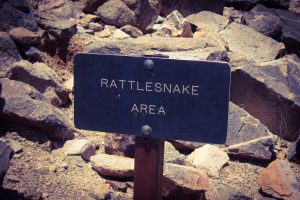
Most Flagstaff residents might say they would prefer to avoid a run-in with a rattlesnake. Though, if you do happen to see a rattlesnake up here on the plateau, it would actually be an amazingly special experience. Yes, I know – rattlesnakes (and most reptiles, for that matter) are not so cute and cuddly as many other animals, but what they lack in fuzzy furriness, they make up for with gripping fascination!
What exactly is a rattlesnake?
These snakes are actually pit vipers – vipers that have a pair of depressions on each side of the head containing a heat-sensing organ that helps to detect both prey and predators. Pit vipers have long, hollow fangs that usually rest on the roof of the mouth, and glands that allow them to produce venom. The fangs rotate forward during a strike to deliver the venom. Their rattles are harmless – they are made of keratin (like our own hair and fingernails) and will not grow back if they are broken off. Many rattlesnakes have large, triangular-shaped heads (a tell-tale sign of a pit viper), and of course, their rattles are also a giveaway. There are two main types of venoms in rattlesnakes – hemorrhagic venom which aids in pre-digestion of slow dying prey, and neurotoxic venom that kills prey more quickly through paralysis without pre-digestion. Some venoms are extremely potent, some are mild versions of either type, and some are mixtures of both. Did you also know that venom from pit vipers has been used therapeutically, including in modern medicine? Not only are antivenins created from the venom, but drugs and therapies for maladies like high blood pressure and cancer have been created as well from certain venom components.
Now, residents of Arizona, you should know how special you are for living in this great state because we take home the rattlesnake “grand prize” – there are more species of rattlesnakes here in Arizona than any other state. In fact, 13 of the 36 different types of rattlesnakes live here in the Grand Canyon state (see Arizona Game and Fish website for additional details). Multiple rattlesnakes reside in Coconino County. But only one of these rattlers prefers the high elevations of Flagstaff: the Arizona Black Rattlesnake. It is possible to view other rattlesnakes of Coconino County in and around Flagstaff (such as a Prairie/Hopi Rattlesnake which can reside more to the east/northeast of Flagstaff), but it is much more unlikely. If you have the chance to see any of them in the wild, luck has been on your side, indeed!
Many a time I have witnessed humans pass by or nearly step on rattlesnakes without ever knowing there was a snake there. I’ve seen rattlesnakes sunning on stone walls or rocks in parks, with scores of people passing and never noticing because the rattlesnake simply wants to maintain crypsis. I’ve seen people in a hiking group step directly over a rattlesnake unbeknownst to them. One time, someone’s boot print in my hiking party was touching a coiled rattlesnake. I was last in the line of hikers and noticed the snake, which had not moved, and I called everyone back so they could see that they had all, in fact, walked directly over a rattlesnake without incident. It was only when a group of people were surrounding the snake that it began giving warnings by rattling its tail – a sign for us to back off.
Arizona Black Rattlesnakes are no different. They do their best to attempt blending into the environment, and often have a very dark brown to black background color with light-colored white or yellow bars edging dark blotches. Not only is that helpful on the dark volcanic soils of northern Arizona, but it is also helpful at these high elevations where temperatures do not become quite as hot! Black absorbs more energy and helps these cold-blooded creatures warm up and create energy faster and more easily. Juveniles appear quite different with a light-colored greyish background and very dark blotches – it is a quite striking pattern. Although many Arizona Black Rattlesnakes do fit these descriptions around Flagstaff, they can have other colorations, too. Many rattlesnakes can change coloration by altering melanin concentrations. Color change can happen due to rising or falling body temperatures, stress, or as a way to camouflage.
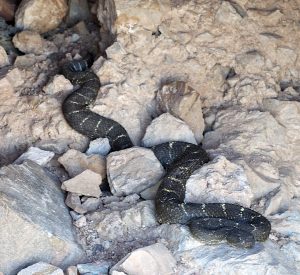
Photo by M. Stewart, National Park Service
CC BY 2.0
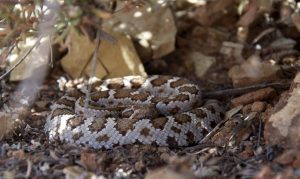
Photo by M. Stewart, National Park Service
CC BY 2.0
The stigma surrounding rattlesnakes has long been bestowed by human fear and misunderstanding of these creatures. Rattlesnakes literally have a bad name. For example, in mythology, Cerberus was a dog with at least three heads, a snake-like tail, and the claws of a lion. It was a “hellhound” – a watchdog of Hades (the god of the underworld). Cerberus sat at the gates of the underworld controlling the entrance of the dead and preventing them from leaving. Cerberus is also the species name for the Arizona Black Rattlesnake. How’s that for a bad name? You could probably consider cerberus an improvement over the species name it was originally given, lucifer – named after the devil himself! Many of the pit vipers of Arizona, including the Arizona Black Rattlesnake, are in the genus Crotalus which translates to “rattle, clapper, or castanet”. Therefore, the scientific name for the Arizona Black Rattlesnake (Crotalus cerberus) could generally be translated as the “rattling hellhound”. Sounds cheery, doesn’t it?
Additional Fun Facts about the Arizona Black Rattlesnake (Crotalus cerberus)
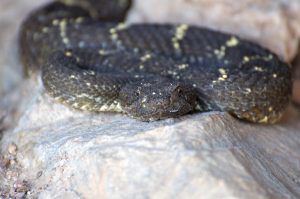
Photo by M. Stewart, National Park Service
CC BY 2.0
- Thrives at higher elevations, and can often be found in and around rock piles, pine woodlands, or canyon bottoms, and especially near wet habitats like washes, creeks, and springs.
- Around Flagstaff, these rattlesnakes often prefer areas around clusters of Gambel oaks where there are many boulders and piles of downed logs available. Ever sat down on a log in the forest and found out you sat down right next to a rattlesnake? Yes, it’s happened, so take care before placing your hands, feet, and other body parts on rocks and logs while out hiking.
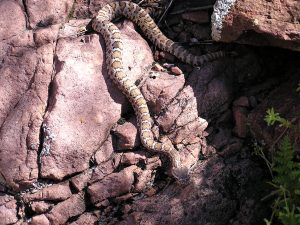
Juvenile Arizona Black Rattlesnake
Photo by E. Nowak, National Park Service
CC BY 2.0 - Can grow up to 2.5 – 3 feet long, but are usually at the smaller end of the size range at the higher elevations of Flagstaff.
- Diet mostly consists of lizards, birds, and rodents.
- Gives live birth.
- Usually hibernates in dens from about October to April, and often den communally with other snakes.
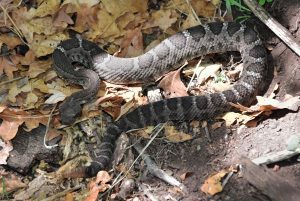
Arizona Black Rattlesnake
Photo by Dyan Bone, U.S. Forest Service, Southwestern Region, Kaibab National Forest
CC BY-SA 2.0 - Did you know snakes are social, including Arizona Black Rattlesnakes? They form associations (like friendships) and are selective about with whom they mingle in their communities. Adults are very well connected to others in their community.
- Have a hemorrhagic venom that is comparatively less toxic or potent than other western rattlesnakes.
- Can be found all over Flagstaff, from Walnut Canyon to northeast of the San Francisco Peaks, down to Oak Creek Canyon, and the areas in-between (yes, including within Flagstaff city limits!). Has a distribution beyond these areas to the south and north, and even slightly overlaps in distribution with the Prairie/Hopi Rattlesnake.
Fun Facts about the Prairie/Hopi Rattlesnake (Crotalus viridis)
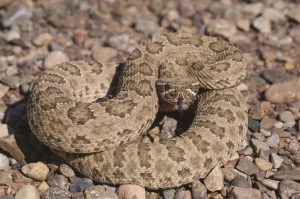
- Viridis is Latin for “green” and refers to the green coloration sometimes seen in this rattlesnake, but coloration in Arizona is usually not predominantly green. Instead, it varies from brown to yellowish tan to pink, red-brown, or gray-brown.
- Marked with a series of large brown blotches that usually have thin, white edges.
- Can grow to 2.5 – 3 feet in length (moderately large).

Photo Credit: National Park Service
Public Domain
- There are actually two subspecies: Crotalus viridis viridis (Prairie Rattlesnake) and Crotalus viridis nuntius (Hopi Rattlesnake).
- The Hopi Rattlesnake is so named because of the Hopi Snake Dance in which the snakes are considered messengers to the spirits of the earth.
- Regularly found at Wupatki National Monument, and is often associated with black-tailed prairie dog towns.
- Preferred habitat around Flagstaff includes volcanic outcrops, grassland and woodland areas. It likes the prairie!
- Diet mainly consists of small mammals, but it can also eat amphibians, lizards, other snakes, birds, eggs, insects, and even carrion.
We have other types of snakes around Flagstaff, too – like the Arizona Mountain Kingsnake (a beautifully banded red, black, and white specimen), Striped Whipsnake, Gophersnakes (these can have an appearance like a rattlesnake and can even mimic a rattle with a hiss), and Terrestrial Gartersnakes (highly prevalent ‘round these parts). Snakes especially like to warm up in the sun early in the mornings, so no matter where you are, keep your eyes peeled and you might be treated to the special sight of a snake patiently awaiting its breakfast!
Remember these key points about rattlesnakes when you see them:
- Leave it alone. The general rule is if you leave it alone, it will leave you alone.
- Give it some space and an escape route. If it doesn’t start to retreat away, give the snake a wide berth if you need to go around it.
- Move slowly and deliberately as opposed to quickly and suddenly to avoid startling a rattlesnake.
- They defend only when startled or attacked. They like to avoid interactions with humans more than anything else!
- Rattlesnakes will not chase you.







